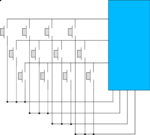Difference between revisions of "Keypad"
(→Introduction) |
|||
| Line 3: | Line 3: | ||
==Introduction== | ==Introduction== | ||
| − | Your Armadeus board allows you to connect a (matrix or not) keypad as input device. | + | Your Armadeus board allows you to connect a (matrix or not) keypad as input device. Keypads are a collection of switches assembled together to emulate a kind of keyboard to ease user interaction with your system. |
==Solutions== | ==Solutions== | ||
Revision as of 22:10, 4 December 2009
How to connect a keypad to your Armadeus board
Contents
Introduction
Your Armadeus board allows you to connect a (matrix or not) keypad as input device. Keypads are a collection of switches assembled together to emulate a kind of keyboard to ease user interaction with your system.
Solutions
There are several solutions to connect a matrix keypad to your Armadeus board:
Keypad directly connected to i.MXL/27
One GPIO for one key
This type of keypad generally called "common ground keypad" is the easiest one to build. If you need more than 6 keys it is however "GPIO consuming".
Under Test...
Matrix keypads on i.MX27
Matrix keypads on i.MXL
Driver for i.MX GPIO controlled keypads
| By default your board supports a direct connection with a 4x4 matrix keypad using the CSI lines: CSI_MCLK, CSI_D0...CSI_D6.
The driver uses the i.MXL GPIO's internal pull-up, therefore your board does not need any additional external resistor.
{add a big picture of the keypad link with APF_DEV_LIGHT} {add a big picture of the keypad link with APF_DEV_FULL} |
FPGA solution
Development are also ongoing to connect matrix keypads using the FPGA...
Test
- use target/demos/keypad_test/ test tool
- If you have a graphical LCD connected to your board (= virtual terminal), then you should see what you type.
- If you don't have any virtual terminal, but only the serial console:
# cat /sys/class/input/input0/event0/dev 13:64
If corresponding device node in /dev/input/ is not existing, then:
# mkdir -p /dev/input # mknod /dev/input/event0 c 13 64
# cat /dev/input/event0
Then you should see weirds characters when pressing keyboard keys:
�,~~_�,}�}�3T,QToT6,TT�,�;��, � �
Links
external links (for exemple: locomo driver model)
